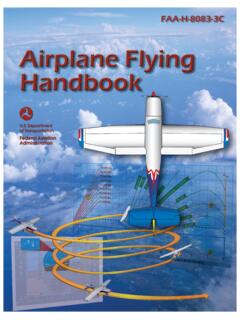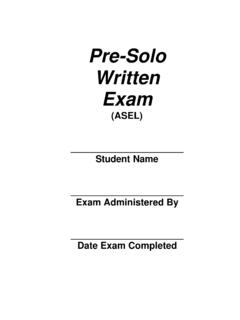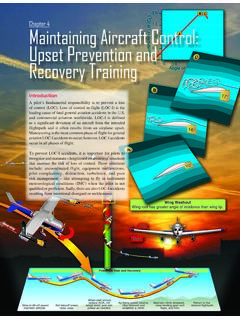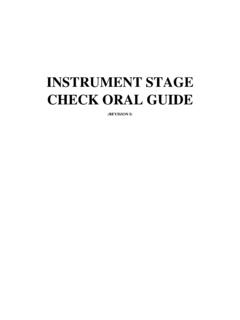Transcription of Cessna 172 Maneuver Description Guide Private Pilot ...
1 C-172 Maneuver Description Guide Cessna 172 Maneuver Description Guide Private Pilot & Commercial Pilot 2020 C-172 Maneuver Description Guide Preface This C-172 Maneuver Description Guide (MDG) should be considered supplemental to the information contained in FAA Publication FAA-H-8083-3B, airplane flying handbook (AFH). While the AFH provides detailed information regarding flight maneuvers, it does not provide specific procedures for use in the Cessna 172. For this reason, the MDG and AFH should be seen as complementary documents. Instructors and students should also be mindful of how maneuvers will be evaluated on the Practical Exam. This information is clearly laid out in the Airman Certification Standards (ACS) for the Private Pilot or Commercial Pilot Practical Examination.
2 It will be helpful to consult the ACS during training to gain a clear understanding of what the Designated Pilot Examiner will be observing during the Practical Examination. The Cessna Pilot Training courses are also an excellent reference and should be consulted. The videos embedded in each module provide helpful techniques and pointers for all the flight maneuvers in your syllabus. The concept of basic attitude flying (AFH, Ch 3) is critical for Private Pilots and must be emphasized from the very first flight. Every Maneuver performed in this MDG is based on an aircraft attitude, that is, an angular relationship between the airplane and the horizon. For example, understanding the attitude you should see when turning from base to final in the landing pattern will ensure you never get slow or have to worry about an approach stall.
3 Additionally, every flight profile (straight and level, turn, climb, descent, etc.) in the airplane is a combination of a power setting, nose attitude, and elevator trim. You should always think Power, Attitude, Trim when performing every Maneuver . This MDG does not include procedures for the 172RG; the Cessna 172RG POH should be consulted for further enumeration of operating procedures when flying these aircraft. C-172 Maneuver Description Guide I. Normal Takeoff, Traffic Pattern, Landing Normal Takeoff and Climb Set-Up Before Takeoff Checklist complete Runway and final approach areas clear, announce intentions Centerline, nose wheel straight, verify runway you are on and compass heading Reference point straight ahead for maintaining centerline Heels on the floor of airplane Procedure Full power (in 3-5 sec.)
4 To max), Right rudder as needed, o ! Keep hand on throttle to reject if necessary! T s and P s in the green Check engine gauges Airspeed alive - announce Rotate and smoothly pitch slightly up at liftoff speed: 55 KIAS (normal takeoff) Check coordination by looking down the runway Pitch for VY (based on sight picture - basic attitude flying !) Takeoff trim position is a starting point and may need to be adjusted Maintain straight track over centerline and upwind leg o (Look for a safe emergency landing site) If staying in the pattern, begin crosswind turn at 700 AGL At 1000 feet AGL: Pitch for 90 KIAS cruise climb Trim and scan for traffic, monitor changing altitude Complete climb checklist Proceed to working area at 3,000 MSL or above Key Reminders At 55 knots, rotate to climb attitude.
5 This is one of the fundamental sight pictures to learn Add of gust spread or more to all airspeeds in gusty conditions Pick downrange reference point to maintain the upwind track Reject the takeoff if centerline cannot be maintained Hand stays on throttle until 1000ft AGL C-172 Maneuver Description Guide Crosswind Takeoff and Climb Set Up Same as normal takeoff procedure Note wind direction/velocity & displace yoke fully into wind Procedure Full power (in 3-5 sec. to max), Right Rudder as needed, o ! Keep hand on throttle to reject if necessary! T s and P s in the green , Check engine gauges Airspeed alive -announce Begin to slightly reduce aileron input as speed increases Rotate and smoothly pitch slightly up at liftoff speed: 55 KIAS (normal takeoff) Maintain crosswind slip and centerline upon liftoff (Windward side wing will dip down on rotate into the forward slip) Pitch for VY, based on sight picture (basic attitude flying !)
6 Maintain straight track and return to coordinated flight by crabbing into the wind once out of ground effect If staying in the pattern, begin crosswind turn at 700 AGL At 1000 feet AGL: Pitch for 90 KIAS cruise climb Trim and scan for traffic Complete climb checklist Key Reminders: Aileron into wind to control drift The airspeed alive call is done early in the takeoff roll and allows you to abort the takeoff if your airspeed indicator is inoperative Wind conditions may require sustained aileron input into the wind to maintain runway centerline Pick downrange reference point to maintain the upwind track Add of gust spread or more to all airspeeds in gusty conditions Hand stays on throttle until 1000ft AGL C-172 Maneuver Description Guide Normal/ Crosswind Approach and Landing 10 Miles Out Listen to AWOS Make initial radio call Proceed inbound at 2,500 MSL Pattern Entry Weather information received.
7 Appropriate runway chosen Pattern entry: On the 45 degree bearing to the downwind, at pattern altitude Brief: Traffic awareness, wind planning, any special precautions, Descend to 2000 MSL Enter the traffic pattern at 90 KIAS (~2200 RPM) Fly a rectangular course appropriate for the winds/ type of approach and other traffic Downwind Runway should be about to up the wing spar for normal spacing 2,000 MSL, 90 knots Bank angles no greater than 30 in the pattern At the abeam position, complete pre-landing checklist Abeam the intended point of landing o Pre-landing checklist complete o Power set to ~1500 RPM o First notch of flaps o Pitch and trim for 80 KIAS o Ensure you memorize this sight picture At 45 degree bearing beyond the intended point of landing Confirm ~800 AGL Radio call Adjust power if necessary Turn toward base Lower second notch of flaps (during turn to base)
8 On the base leg (90 degrees of turn) Pitch and trim for 70-75 KIAS (note the sight picture) Adjust power if necessary Make radio call Check final approach course is clear Confirm 500-600 AGL. Turn toward the Final Approach course Lower third notch of flaps (during turn to final) On final Pitch and trim for 65-70 KIAS (sight picture, aiming point) Adjust power if necessary Note PAPI lights (if available) Short Final Cross wind correction entered (wing down, top rudder) Confirm on runway centerline Maintain aiming point until numbers go under nose of aircraft C-172 Maneuver Description Guide Crossing Threshold As runway numbers disappear under nose of airplane, shift scan long (to end of runway) In ground effect Momentary level off (nose to horizon)
9 To arrest rate of descent Smoothly reduce power is idle Maintain centerline, 100% of scan is outside As airplane slows, more aft pressure on yoke is required As airplane begins to settle, slowly increase pitch attitude Touch-down attitude should be approximately the same as climb out nose attitude Touch down on the runway centerline, no lateral drift, nose in line with runway For touch-n-go Carb heat in Flaps up Stabilized on the runway centerline Hand on throttle, eyes outside Throttle full open Full stop landings Roll to a stop and exit runway, using brakes sparingly. Complete after landing checklist after crossing the hold short lines. Key Reminders A good landing begins with flying a good, stable pattern and approach Understanding the sight picture during each phase of the pattern will greatly improve your ability to consistently fly a safe approach and landing Do not use more than 30 angle of bank in the pattern Adhere to the Stabilized Approach concept on final o Fully configured for landing by the time you are wings level on final o Aligned with the runway o No greater than 500 feet per minute descent o Airspeed stabilized at 65-70 knots (unless short field landing)
10 O If unable to maintain these parameters below 300 AGL, execute a go around/rejected landing o Additionally, it you roll out on final and your altitude requires a power adjustment to idle, execute a go around/rejected landing Go-Arounds / Rejected Landing Procedure Full Power, carb heat off (as required) Flaps 20 Eyes outside pitch to horizon, positive rate of climb Flaps 10 Accelerate to VY (or Vx if required for obstacles) Flaps 0 (after clear of any obstacles) Resume normal climb out Key Reminders Power FIRST, control pitch/rudder to maintain coordination airspeed and a proper attitude, re trim when able Retracting flaps too much/too quickly may cause an excessive loss of lift and altitude, keep the airplane stabilized.








